Class 10 History Key Concepts - Chapter 3 Nationalism in India
The key concepts for the entire chapter on nationalism in India are provided in this document, which is concise and will be useful for reviewing and taking notes.
The First World War, Khilafat, and Non-Cooperation
- National Movement was spreading in new areas in 1919 and incorporating new social groups and developing new modes of struggle.
- Mahatma Gandhi came to India and The Idea of Satyagraha emphasized the power of truth and the need to search for truth.
- He advocated that physical force was not necessary to fight the oppressor.
- In 1916, he travelled to Champaran in Bihar to inspire the peasants to struggle against the oppressive plantation system.
 Mahatma Gandhi broke the Salt Law
Mahatma Gandhi broke the Salt Law
The Idea of Satyagraha
- Return to India: Mahatma Gandhi returned from South Africa in January 1915, bringing with him the method of satyagraha, which emphasized non-violent resistance based on truth.
- Concept of Satyagraha: Focused on non-violence and moral persuasion to appeal to the oppressor’s conscience, aiming for truth to ultimately prevail without the use of physical force.
- Early Satyagraha Movements:
1. Champaran (1917): Led a struggle against the oppressive plantation system in Bihar.
2. Kheda (1917): Supported Gujarat peasants demanding relaxation of revenue collection due to crop failure and plague.
3. Ahmedabad (1918): Organized a satyagraha for cotton mill workers.
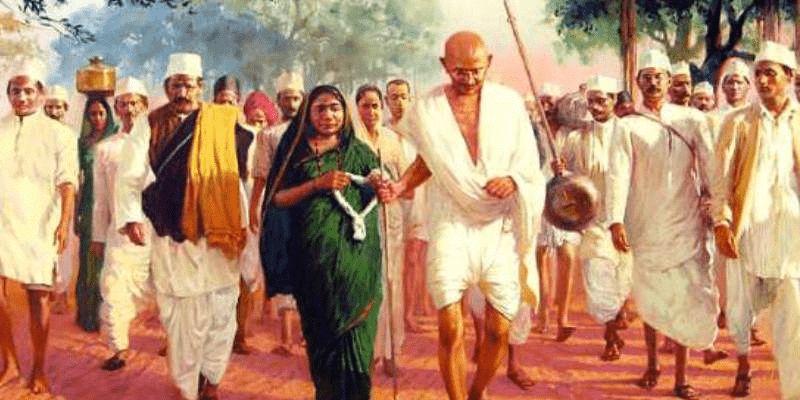 Mahatma Gandhi leading the salt march
Mahatma Gandhi leading the salt march
The Rowlatt act
- Rowlatt Act (1919): Gave the government power to repress political activities and detain people without trial for two years; opposed by Indian leaders.
- Nationwide Satyagraha: Gandhi launched a non-violent movement against the Act on 6 April 1919, organizing hartals (strikes), rallies, and protests.

- Repression and Jallianwalla Bagh Massacre: British crackdown led to violence, culminating in the Jallianwalla Bagh massacre (13 April 1919) where General Dyer's troops fired on a crowd, killing hundreds.
- Aftermath of the Massacre: Widespread protests and strikes followed; British repression intensified. Gandhi called off the movement due to increasing violence.
- Need for a Broader Movement: Gandhi sought to unite Hindus and Muslims; he took up the Khilafat isse to defend the Ottoman Khalifa and build a unified national movement.
- Non-Cooperation Movement (1920): At the Calcutta Congress session, Gandhi convinced leaders to launch the movement, combining the Khilafat cause with the fight for swaraj.
 Jallianwala Bagh Massacre
Jallianwala Bagh Massacre
Why Non-cooperation?
- Gandhi’s Belief: In Hind Swaraj (1909), Gandhi argued that British rule relied on the cooperation of Indians; non-cooperation could lead to the collapse of British rule within a year.
- Plan for the Movement:
Unfold in stages:
- Surrender of titles and boycott of civil services, army, police, courts, legislative councils, schools, and foreign goods.
- If repressed, escalate to a full civil disobedience campaign. - Mobilization Efforts: Gandhi and Shaukat Ali toured to gather support in 1920.
- Congress Debate:
- Concerns over boycotting council elections and potential violence caused internal divisions.
- A compromise was reached at the Nagpur Congress session in December 1920, adopting the Non-Cooperation programme.
Differing Strands Within The Movement
In January 1921, the Non-Cooperation-Khilafat Movement began. In this movement, various social groups participated, but the term meant different things to different people.
The Movement in the Towns
- Middle-Class Participation: Students left government schools, teachers and headmasters resigned, and lawyers stopped practicing. Council elections were boycotted, except in Madras where the Justice Party participated.
- Economic Impact: Boycott of foreign goods, picketing of liquor shops, and burning of foreign cloth. Foreign cloth imports reduced by nearly half between 1921 and 1922, boosting Indian textile production.
- Challenges and Slowdown: Khadi cloth was expensive; the poor found it hard to afford, making prolonged boycott difficult. Lack of alternative Indian institutions led many students, teachers, and lawyers to return to British institutions.
Rebellion in the countryside
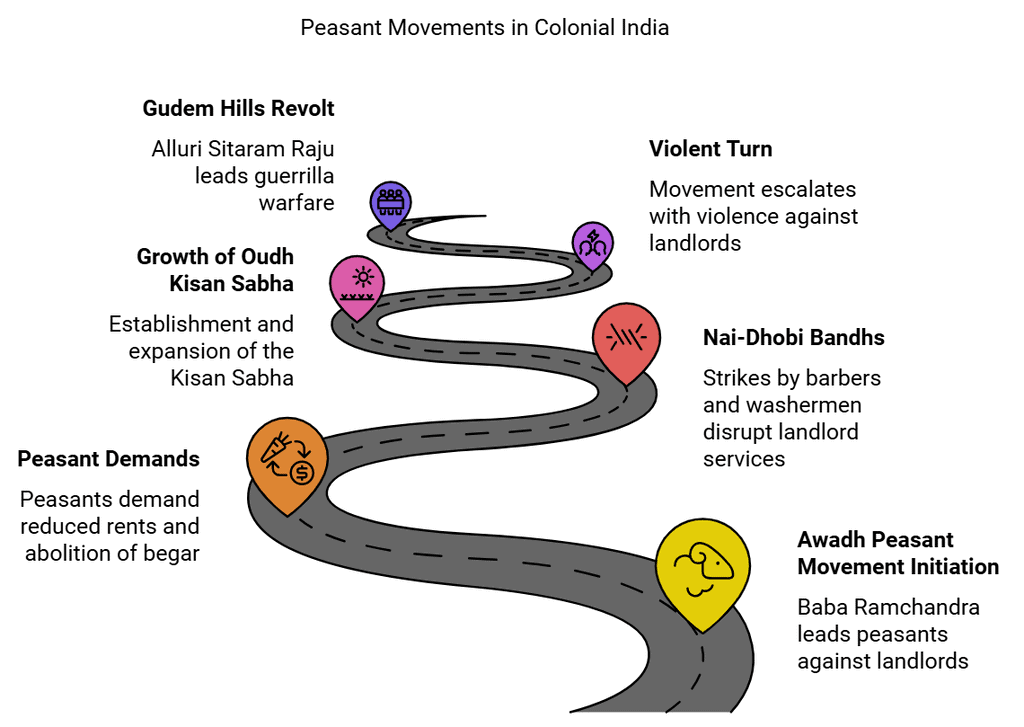
- Awadh Peasant Movement: Led by Baba Ramchandra, aimed at addressing high rents, forced labor (begar), and eviction by landlords.
- Demands of Peasants: The movement called for reduced revenue, abolition of begar, and social boycotts of oppressive landlords.
- Nai-Dhobi Bandhs: Panchayats organized strikes by barbers and washermen to disrupt landlord services.
- Growth of the Oudh Kisan Sabha: Jawaharlal Nehru helped establish the Oudh Kisan Sabha, which grew to over 300 branches by late 1920.
- Violent Turn: In 1921, the movement saw violence with attacks on landlords' houses, bazaar looting, and grain seizures.
- Gudem Hills Revolt: Led by Alluri Sitaram Raju, who used guerrilla warfare against British rule, despite Gandhi’s non-violent principles.
Swaraj in the Plantations
- For plantation workers in Assam, freedom meant the right to move freely in and out and retaining a link with the village from which they had come.
- Under the Inland Emigration Act of 1859, plantation workers were not permitted to leave the tea gardens without permission.
- After they heard of the Non-Cooperation Movement, thousands of workers left the plantations and headed home.
- Unfortunately, they never reached their destination and were caught by the police.
- They were brutally beaten up during this process.
Towards Civil Disobedience
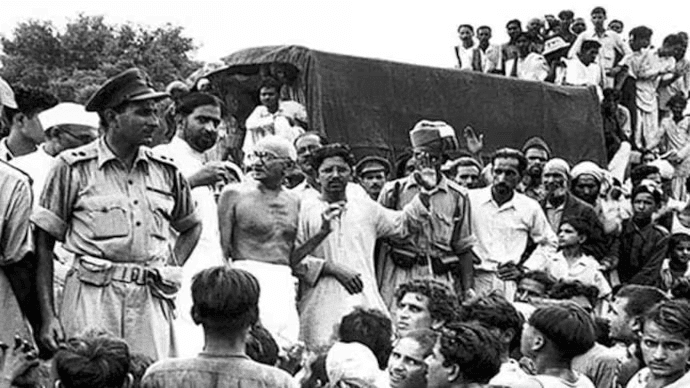
- Withdrawal: In February 1922, Gandhi withdrew the Non-Cooperation Movement due to increasing violence; believed satyagrahis needed training.
- Internal Congress Debate:
- C. R. Das and Motilal Nehru formed the Swaraj Party to push for council politics.
- Younger leaders like Jawaharlal Nehru and Subhas Chandra Bose favored radical mass agitation and complete independence. - Economic Depression Impact: Falling agricultural prices from 1926, collapse after 1930, leading to rural distress.
- Simon Commission (1928): All-British body, greeted with "Go back Simon" protests; opposed by Congress and Muslim League.
- Dominion Status Offer (1929): Lord Irwin's vague offer rejected; radicals pushed for full independence.
- Lahore Congress (1929): Led by Jawaharlal Nehru, formal demand for 'Purna Swaraj' (full independence); 26 January 1930 declared Independence Day, but gained little public attention. Gandhi aimed to connect freedom to daily issues.
The Salt March and the Civil Disobedience Movement
- Gandhiji gave the call for Civil Disobedience Movement.
- He chose ‘Salt’ as the symbol of unity of the nation. Called the ‘Salt Tax’ as most inhuman. The movement started on 31 January 1930. He made eleven demands in a letter to the Viceroy Lord Irwin. His demands covered every class from industrialists to peasants.
- Famous Dandi March began on March 12, 1930. On 6th April 1930, Gandhiji reached Dandi, a village in Gujarat and broke the Salt Law by boiling water and manufacturing salt. Thus began the Civil Disobedience Movement.
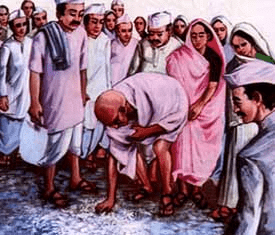 Gandhiji breaking the salt law
Gandhiji breaking the salt law
- The Non-Cooperation Movement (1920-22) attempted to bring the government to a standstill by non-cooperating with the administration.
- The Civil Disobedience Movement aimed at paralysing the government by performing illegal acts.
- Boycott of foreign goods, non-payment of taxes, breaking forest laws were its main features.
- The British Government followed a policy of brutal repression. Arrested all the leaders including Gandhiji and Nehru. Nearly 100,000 people were arrested.
- Lord Irwin, the Viceroy, signed a pact with Gandhiji on 5 March 1931. Gandhiji agreed to attend the Second Round Table Conference and the British agreed to release all political prisoners.
- Gandhiji returned from the Second Round Table Conference disappointed in December 1931. Civil Disobedience started again.
- By 1934 the Movement lost its momentum.
How Participants saw the Movement
- To the countryside: Rich peasant communities expected the revenue tax to be reduced, when the British refused to do so, they did not rejoin the movement in 1932.
- The Poor were the peasants who rented the land from landlords: Depression made them unable to pay rent and wanted it to be reduced. Their relationship with the Congress became uncertain.
- The rich peasants supported the movement to reduce revenue rates but were disappointed when the movement was called off in 1931 without changes to revenue policies.
- The Business Classes: After the war, their huge profits were reduced, wanted protection against import of foreign goods. Thefailure of the Round Table Conference, curbed their enthusiasm for the Civil Disobedience Movement.
- They formed organizations like the Indian Industrial and Commercial Congress and the Federation of Indian Chamber of Commerce and Industries (FICCI) but became cautious after the Round Table Conference due to concerns about militant activities and the influence of socialism .
- The industrial working class did not participate in a large number. They joined because of low wages and poor working conditions. Congress was reluctant to include workers’ demands as it would alienate the industrialists.
- Women and the Civil Disobedience Movement: 1930 was the year when women entered the struggle for Independence on a massive scale. During Gandhiji’s Dandi March, they joined protest marches, picketed foreign clothes and shops. But Congress did not encourage them or gave them important posts in the organisation.
The Limits of Civil Disobedience
- Dalit Movement: Many dalits (untouchables) were not drawn to the idea of swaraj. Gandhi promoted equality, but many dalit leaders sought political solutions, such as reserved seats and separate electorates.
- Ambedkar-Gandhi Clash: Dr. B.R. Ambedkar demanded separate electorates for dalits at the Round Table Conference. After Gandhi's fast unto death, a compromise led to the Poona Pact (1932), granting reserved seats within a general electorate.
- Muslim Response: After the decline of the Non-Cooperation-Khilafat Movement, many Muslims felt alienated from the Congress. Conflicts arose over representation in assemblies, leading to distrust between communities and a lukewarm response to the Civil Disobedience Movement.
The Sense of Collective Belonging
- Collective belonging comes through experiences of common struggles. A common history and fiction, through folklore, songs and popular prints and symbols.
- Bharat Mata became the symbol of India.
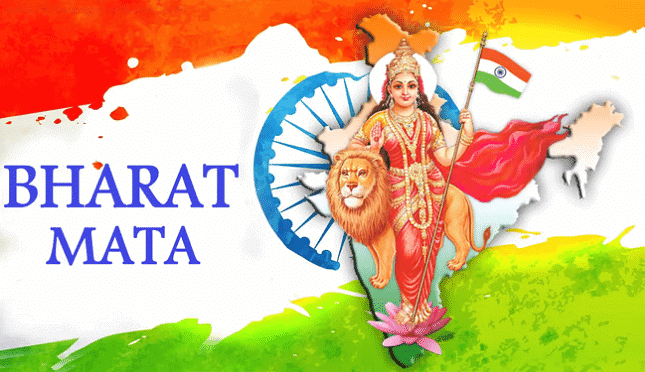
- Bakim Chandra Chattopadhyay created the image in his song “Vande Mataram” in his novel ‘Anand Math’ (1870s). Abanindranath Tagore painted Bharat Mata as a calm, composed, divine and spiritual figure.
- Rabindranath Tagore of Bengal and Natesa Sastri of Madras compiled songs, ballads, myths and folklore.
- Reinterpretation of History: Indians delved into the past history and discovered India’s greatness and achievements in mathematics, literature, religion, culture, philosophy, crafts, and trade.
Conclusion
In the early 1900s, many Indian groups united against colonial rule. Gandhi and the Congress worked to turn this anger into a unified independence movement. However, different groups had different goals and needs, which often led to disagreements and splits within the movement. So, the push for independence had both strong moments of unity and times of conflict.
Frequently Asked Questions
Q.1: State one oppressive feature of Rowlatt Act ?
Ans: It allowed detention of political prisoners without trial for two years.
Q.2: Why people could not afford Khadi ?
Ans: Khadi cloth was often more expensive than mass produced mill cloth and poor people could not afford to buy it.
Q.3: When did Simon Commission arrive in India and why was it boycotted ?
Ans: Simon Commission arrived in India in 1928. It was boycotted because no Indian was member of this Commission.
|
66 videos|800 docs|79 tests
|
FAQs on Class 10 History Key Concepts - Chapter 3 Nationalism in India
| 1. What was the impact of the First World War on the Indian nationalist movement? |  |
| 2. How did the Khilafat Movement contribute to the Indian independence struggle? |  |
| 3. What were the key features of the Non-Cooperation Movement? |  |
| 4. How did the sense of collective belonging develop during the nationalist movements in India? |  |
| 5. What were the main reasons for the shift towards civil disobedience in the Indian independence movement? |  |

















